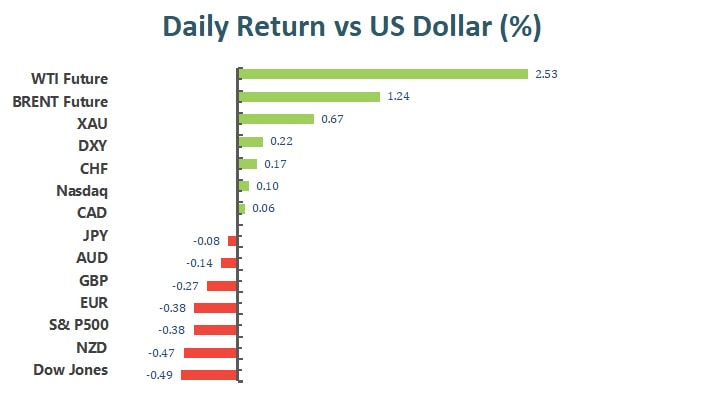Daily market analysis
February 15, 2022
Market Focus
All three major indexes fell sharply after Secretary of State Anthony Blinken announced that he would relocate U.S. diplomatic operations to western Ukraine, a possible sign of an imminent Russian invasion. Ukrainian President Volodymyr Zelensky said Wednesday would be the day of the attack, adding to the uncertainty. However, Ukrainian officials later said Zelensky had not predicted an attack that day, but was skeptical of foreign media reports. At the end of the market, the Dow Jones Industrial Average fell 0.49% to 34,566.17 points, the S&P 500 index lost 0.38% to 4,401.67 and the Nasdaq Composite Index dropped 0.24 points to 13,790.92 points.

Nine of the 11 sectors in the S&P 500 ended lower, with energy falling the most, down 2.24%, followed by financials and healthcare, down 1.11% and 1.09%, respectively. The only winners were consumer discretionary and communications services, which rose 0.58% and 0.32%, respectively. Oil prices rose sharply as a barometer of tensions on the Ukrainian border amid the prospect of potential supply disruptions. However, the sharp rise in oil prices did not prevent energy stocks from falling more than 2%. APA, Marathon Oil and Occidental Petroleum led the declines, which slipped 5.86%, 4.50% and 4.07%, respectively. In addition, healthcare stocks also weighed on the market, weighed by weakness in vaccine makers and investors pulling out on fears that a drop in Covid-19 cases would dent demand for a coronavirus vaccine. Novavax slipped 11.42%, Moderna dropped 11.68%, and Pfizer lost 3.08%. On the other hand, tech stocks performed relatively well on the day, supported by gains in semiconductor stocks. Micron Technology and Advanced Micro Devices led gains of more than 2% and 3%, respectively, after the latter announced that it had completed a acquisition for Xilinx for $50 billion. Meanwhile, Splunk rose more than 9% after it reportedly received a $20 billion takeover offer from Cisco Systems.

Main Pairs Movement:
Tensions between Russia and Ukraine dominated financial markets on Monday, leading to some strong safe-haven demand. The catalyst was a statement from U.S. President Joe Biden, who told Ukrainian President Volodymyr Zelensky on Sunday that the U.S. would respond “quickly and decisively” if Russia made further incursions. Hence, the U.S. dollar and gold benefited the most in a risk-off environment, and were further boosted by comments from St. Louis Fed President Bullard, who reiterated his call for a 100bps rate hike by July 1. Finally, the DXY gained 0.27% and the precious metal was up 0.69%, almost hitting its November 2021 high and hitting a new 2022 high.
The currency was relatively weak against the U.S. dollar as the greenback strengthened. EUR/USD fell for a second day, down 1.10%, back in consolidated range. Finally closed at 1.13057. Sterling was in a similar pattern against the dollar, falling for two days in a row but only down 0.22% to close at 1.35233.
Concerns about supply disruptions continue to push oil prices higher, with prices up around 26% in 2022, with numbers likely to keep refreshing amid tensions between Russia and Ukraine. At the end of the market, the WTI closed at $94.76 a barrel and Brent at $95.70 a barrel.
Technical Analysis:

The EUR/USD pair declined on Monday, continuing to edge lower after last week’s news about the tensions between Russia and Ukraine elevated. The pair was surrounded by bearish momentum most of the day, touching a ten-day low below 1.1310 level during European session. The pair is now trading at 1.1319, posting a 0.23% loss on a daily basis. EUR/USD stays in the negative territory amid stronger US dollar across the board, as safe-haven flows dominated the financial markets amid renewed fears over a Russia-Ukraine military conflict. The risk-off market sentiment lend support to the safe-haven greenback and weighed on EUR/USD pair. In Europe, recent dovish aspect from ECB might keep acting as a headwind for the Euro. Meanwhile investors await for ECB President Christine Lagarde’s speech later in the session, which might provide fresh impetus for the EUR/USD pair.
For technical aspect, RSI indicator 33 figures as of writing, suggesting bear movement ahead. As for the Bollinger Bands, the price is moving alongside the lower band, which indicates that the pair could remain its downside traction. In conclusion, we think market will be bearish as the pair is heading to test the 1.1284 support. A break below that level could open the road for additional losses, as RSI is currently approaching oversold territory.
Resistance: 1.1360, 1.1465
Support: 1.1284, 1.1196, 1.1132
The pair GBP/USD edged lower on Monday, extending its recent pullback from the 1.3645 region that touched last week amid risk-off market mood. The pair dropped to one-week lows below 1.3500 mark during the first half of the European session, but then rebounded slightly to erase some of its intraday’s losses. At the time of writing, the cable stays in negative territory with a 0.24% loss for the day, struggling to climb higher around the 1.3520 area. Reports claiming that Russia could invade Ukraine this week undermined safe-haven assets such as greenback, and the DXY index is now climbing to its ten-day high near 96.30. For British pound, tensions over the Northern Ireland protocol of the Brexit agreement and last Friday’s downbeat UK GDP report might keep weighing on the GBP/USD pair.
For technical aspect, RSI indicator 43 figures as of writing, suggesting that downside is more favored as the RSI stays below the mid-line. As for the Bollinger Bands, the price is moving towards the lower band after crossing below the moving average, therefore the downside traction should persist. In conclusion, we think market will be bearish as long as the 1.3612 resistance line holds. On the downside, near-term losses could be expected if the pair break 1.3512 support as safe-haven flows continue to dominate markets.
Resistance: 1.3612, 1.3739
Support: 1.3512, 1.3456, 1.3372
USDCAD (4-Hour Chart)

After last Friday’s rebound to 1.2740 area, the pair USD/CAD preserved its bullish momentum and climbed higher amid US dollar strength. The pair reached a ten-day top above 1.2780 level during European session, but then pulled back to surrender most of its daily gains. USD/CAD is trading at 1.2735 at the time of writing, losing 0.1% on a daily basis. The greenback was underpinned by surging US Treasury bond yields, as the risk of a further escalation in the conflict between Russia and Ukraine hurt market sentiment and favored the safe-haven greenback. On top of that, rebounding crude oil prices has now put some pressure on USD/CAD pair as WTI reach multi-year highs near $95.00 mark. Investors worry about that the conflict between Russia and Ukraine could disrupt oil supply, which underpinned the commodity-linked loonie.
For technical aspect, RSI indicator 53 figures as of writing, suggesting that the pair could remain its downside movement as the RSI start heading south. As for the Bollinger Bands, the price is falling from the upper band, indicating a continuation of the downside traction. In conclusion, we think market will be bearish as long as the 1.2789 resistance line holds. If Russia invades Ukraine, crude oil prices could surge significantly and probably exceed $100 per barrel.
Resistance: 1.2789, 1.2831
Support: 1.2667, 1.2575, 1.2461
Economic Data:
|
Currency |
Data |
Time (GMT + 8) |
Forecast |
|
|
JPY |
GDP (QoQ) (Q4) |
07:50 |
1.4% |
|
|
AUD |
RBA Meeting Minutes |
08:30 |
||
|
GBP |
Average Earnings Index +Bonus (Dec) |
15:00 |
3.8% |
|
|
GBP |
Claimant Count Change (Jan) |
15:00 |
-28.0K |
|
|
EUR |
German ZEW Economic Sentiment (Feb) |
18:00 |
55.0 |
|
|
USD |
PPI (MoM) (Jan) |
21:30 |
0.5% |
|
-
Global - English

-
United Kingdom - English

-
France - Français

-
Spain - Español

-
Portugal - Português

-
Italy - Italiano

-
Germany - Deutsch

-
Turkey - Türkçe

-
MENA - العربية

-
MENA - English

-
Asia - English

-
India - English

-
Indonesia - Indonesia

-
Japan - 日本語

-
South Korea - 한국어

-
Malaysia - Bahasa Malaysia

-
Malaysia - English

-
Philippines - English

-
Vietnam - Tiếng Việt

-
Thailand - ไทย

-
China - 简体中文

-
China - 繁體中文


This site uses cookies to provide you with a great user experience.
By using vtmarkets.com, you accept
our cookie policy.

























